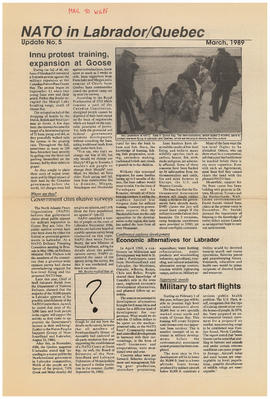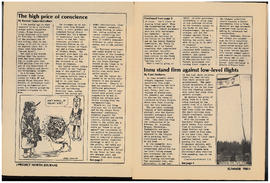Área de título y declaración de responsabilidad
Título apropiado
Tipo general de material
- Textual records
- Graphic materials
- Objects
Título paralelo
Otra información de título
Título declaración de responsabilidad
Título notas
- Complementos del título: Ontario Branches
Nivel de descripción
Institución archivística
Código de referencia
Área de edición
Declaración de edición
Declaración de responsabilidad de edición
Área de detalles específicos de la clase de material
Mención de la escala (cartográfica)
Mención de proyección (cartográfica)
Mención de coordenadas (cartográfica)
Mención de la escala (arquitectónica)
Jurisdicción de emisión y denominación (filatélico)
Área de fechas de creación
Fecha(s)
-
1975-2007 (Creación)
- Creador
Área de descripción física
Descripción física
55 photographs
12 buttons
3 floppy disks
2 VHS
4 audiocassettes
Área de series editoriales
Título apropiado de las series del editor
Títulos paralelos de serie editorial
Otra información de título de las series editoriales
Declaración de responsabilidad relativa a las series editoriales
Numeración dentro de la serie editorial
Nota en las series editoriales
Área de descripción del archivo
Nombre del productor
Historia administrativa
The Women’s International League for Peace and Freedom (WILPF) originated in the convening of over one thousand women from 12 different countries, on April 28, 1915, to address the outbreak of World War One. The International Congress of Women had met regularly, since the late 19th century, to further women’s rights and the suffragette cause.
The Congress adopted 12 resolutions aimed at facilitating a just and lasting peace; it also designated an International Committee of Women for Permanent Peace (ICWPP) to help further its goals. During the second meeting of the ICWPP, in May 1919, the Committee re-named itself the Women’s International League for Peace & Freedom.
WILPF headquarters are located in Geneva, Switzerland, where the organization operates under the governance of its international bodies with national sections reporting to the international headquarters. The number of WILPF national sections has varied over time and now includes representation from Africa, the Americas, South Asia, Asia Pacific, Europe, and the Middle East.
WILPF is mandated to further feminist pacifist causes and to facilitate peaceful social change, opposing militarist education and working to end all forms of violence and discrimination, including racism. The organization adopted ecological sustainability as a key goal in the 1980s.
Within Canada, the earliest known WILPF branch or group was founded in Vancouver, British Columbia, in either 1917 or 1921. Several early Vancouver members were associated with the suffragette movement as well as with the Co-operative Commonwealth Federation (CCF) political party. By the 1930s, branches also opened in Toronto, Winnipeg, Regina, Calgary and Edmonton. WILPF membership declined dramatically in Canada, as it did across the globe, in the 1940s and 1950s: only the Vancouver branch remained active in Canada in the 1950s.
WILPF Toronto reopened in the early 1980s, working on disarmament campaigns at both local and international levels. It reopened again in 1996 after several years’ hiatus.
WILPF Toronto was instrumental in developing the Clothesline Project to honour and commemorate women victims of male violence.
In Eastern Ontario, an Ottawa WILPF branch was founded in the late 1970s and included dozens of members: Ottawa groups were also active at Carleton University and the University of Ottawa. The Ottawa branch had functioning committees and an elected steering committee. The Ottawa branch opposed NATO flight testing over Innu territory and supported the STAR campaign to Stop the Arms Race: a WILPF United States initiative.
In 1993 the Ottawa branch published “The Canadian Women’s Budget,” presenting an alternative federal budget to Canada’s military expenditures. The Ottawa Branch also regularly published the newsletter, "WILPF News," every two months.
Both the Ottawa and Toronto branches combined local, with international, actions and initiatives, opposing military intervention abroad as well as opposing local Canadian NATO (North Atlantic Treaty Organization) testing of missiles, and pushing for disarmament initiatives via petitions, letter-writing campaigns, demonstrations, and panel discussions.
---
La Ligue internationale des femmes pour la paix et la liberté (LIFPL) est née de la réunion de plus d'un millier de femmes de 12 pays différents, le 28 avril 1915, pour faire face au déclenchement de la première guerre mondiale. Le Congrès international des femmes se réunissait régulièrement, depuis la fin du XIXe siècle, pour promouvoir les droits des femmes et la cause des suffragettes.
Le congrès a adopté 12 résolutions visant à faciliter une paix juste et durable ; il a également désigné un Comité international des femmes pour la paix permanente (CIFPP) pour l'aider à atteindre ses objectifs. Lors de sa deuxième réunion, en mai 1919, le Comité s'est rebaptisé Ligue internationale des femmes pour la paix et la liberté.
Le siège de la WILPF est situé à Genève, en Suisse, où l'organisation fonctionne sous la direction de ses organes internationaux, les sections nationales rendant compte au siège international. Le nombre de sections nationales de la WILPF a varié au fil du temps et comprend aujourd'hui des représentants de l'Afrique, des Amériques, de l'Asie du Sud, de l'Asie-Pacifique, de l'Europe et du Moyen-Orient.
La WILPF a pour mission de promouvoir les causes féministes pacifistes et de faciliter les changements sociaux pacifiques, en s'opposant à l'éducation militariste et en œuvrant pour mettre fin à toutes les formes de violence et de discrimination, y compris le racisme. Dans les années 1980, l'organisation a fait de la durabilité écologique l'un de ses principaux objectifs.
Au Canada, la première branche ou le premier groupe connu de la WILPF a été fondé à Vancouver, en Colombie-Britannique, en 1917 ou en 1921. Plusieurs des premiers membres de Vancouver étaient associés au mouvement des suffragettes ainsi qu'au parti politique Co-operative Commonwealth Federation (CCF). Dans les années 1930, des sections s'ouvrent également à Toronto, Winnipeg, Regina, Calgary et Edmonton. Dans les années 1940 et 1950, le nombre de membres de la WILPF diminue considérablement au Canada, comme partout dans le monde : seule la section de Vancouver reste active au Canada dans les années 1950.
La WILPF de Toronto a rouvert ses portes au début des années 1980, travaillant sur des campagnes de désarmement aux niveaux local et international. Elle a rouvert ses portes en 1996 après plusieurs années d'interruption.
La WILPF Toronto a joué un rôle déterminant dans le développement du Clothesline Project, qui vise à honorer et à commémorer les femmes victimes de la violence masculine.
Dans l'est de l'Ontario, une section de la WILPF d'Ottawa a été fondée à la fin des années 1970 et comptait des dizaines de membres : Des groupes d'Ottawa étaient également actifs à l'Université Carleton et à l'Université d'Ottawa. La section d'Ottawa disposait de comités fonctionnels et d'un comité directeur élu. La section d'Ottawa s'est opposée aux essais en vol de l'OTAN au-dessus du territoire innu et a soutenu la campagne STAR visant à mettre fin à la course aux armements, une initiative de la WILPF des États-Unis.
En 1993, la section d'Ottawa a publié "The Canadian Women's Budget", qui présente un budget fédéral alternatif aux dépenses militaires du Canada. La section d'Ottawa publie également tous les deux mois le bulletin d'information "WILPF News".
Les sections d'Ottawa et de Toronto ont combiné des actions et des initiatives locales et internationales, s'opposant aux interventions militaires à l'étranger ainsi qu'aux essais de missiles de l'OTAN (Organisation du traité de l'Atlantique Nord) au Canada, et encourageant les initiatives de désarmement par le biais de pétitions, de campagnes d'envoi de lettres, de manifestations et de débats d'experts.
Historial de custodia
Alcance y contenido
--
Le fonds documente les sections de l'Ontario, notamment d'Ottawa et de Toronto. Les documents datent principalement de la fin des années 1970 et du début des années 2000. Le fonds contient des documents administratifs et des dossiers de projets, ainsi que des documents sur la gouvernance des sections, qui reflètent les efforts déployés pour établir une section officielle de la WILPF Canada.
Le fonds documente en particulier les actions des sections locales et internationales pour faire avancer le mouvement de désarmement des années 1980. Il documente également la participation des sections à la campagne STAR (Stop the Arms Race), aux campagnes visant à mettre fin aux essais en vol de l'OTAN au-dessus du territoire innu, à diverses marches et rassemblements. La série administrative du fonds reflète les relations hiérarchiques de la WILPF avec le siège international ainsi que son affiliation avec des organisations pacifistes locales. Le fonds comprend des documents relatifs aux congrès internationaux et de la correspondance avec d'autres sections et branches de la WILPF.
Área de notas
Condiciones físicas
Origen del ingreso
Arreglo
Idioma del material
Escritura del material
Ubicación de los originales
Disponibilidad de otros formatos
Restricciones de acceso
Condiciones de uso, reproducción, y publicación
Instrumentos de descripción
Materiales asociados
WILPF Vancouver branch records are held at the University of British Columbia Library Rare Books and Special Collections.
Issues of the WILPF publication, "WILPF News" are available in the ARCS feminist periodicals collection: JZ 5578 .W6378 with several issues digitized in the Omni catalogue:
https://ocul-uo.primo.exlibrisgroup.com/permalink/
01OCUL_UO/17ga5ig/alma991005092989705161

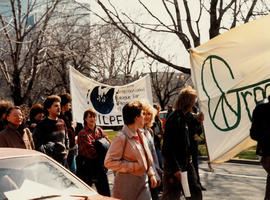
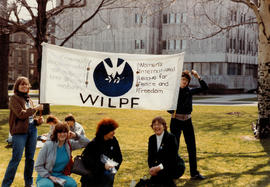

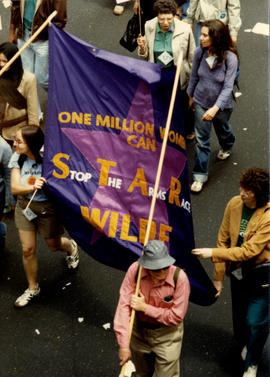
![Two individuals [Dr. Barb Giles and Deb] holding Refuse the cruise banner](/uploads/r/archives-et-collections-speciales/9/1/3/9137fa64d866d5480a0c77455852e0af53dd5d18e8ddd510f2b2088d44df09a8/10-114-S2-F13-I6_Refuse_the_Cruise_Protest_142.jpg)
![Demonstratie: Samenwekingsverhand Stope de N-bom/stop de kernwapenwedloop... [Demonstration: Collaborative Trade Stope the N-bomb/stop the nuclear arms race] 1](/uploads/r/archives-et-collections-speciales/d/8/1/d81882974299b557247a9e6405710a6e365a549235b25f1ffe7eea378706c53c/10-114-S2-F17-I1-1_142.jpg)
